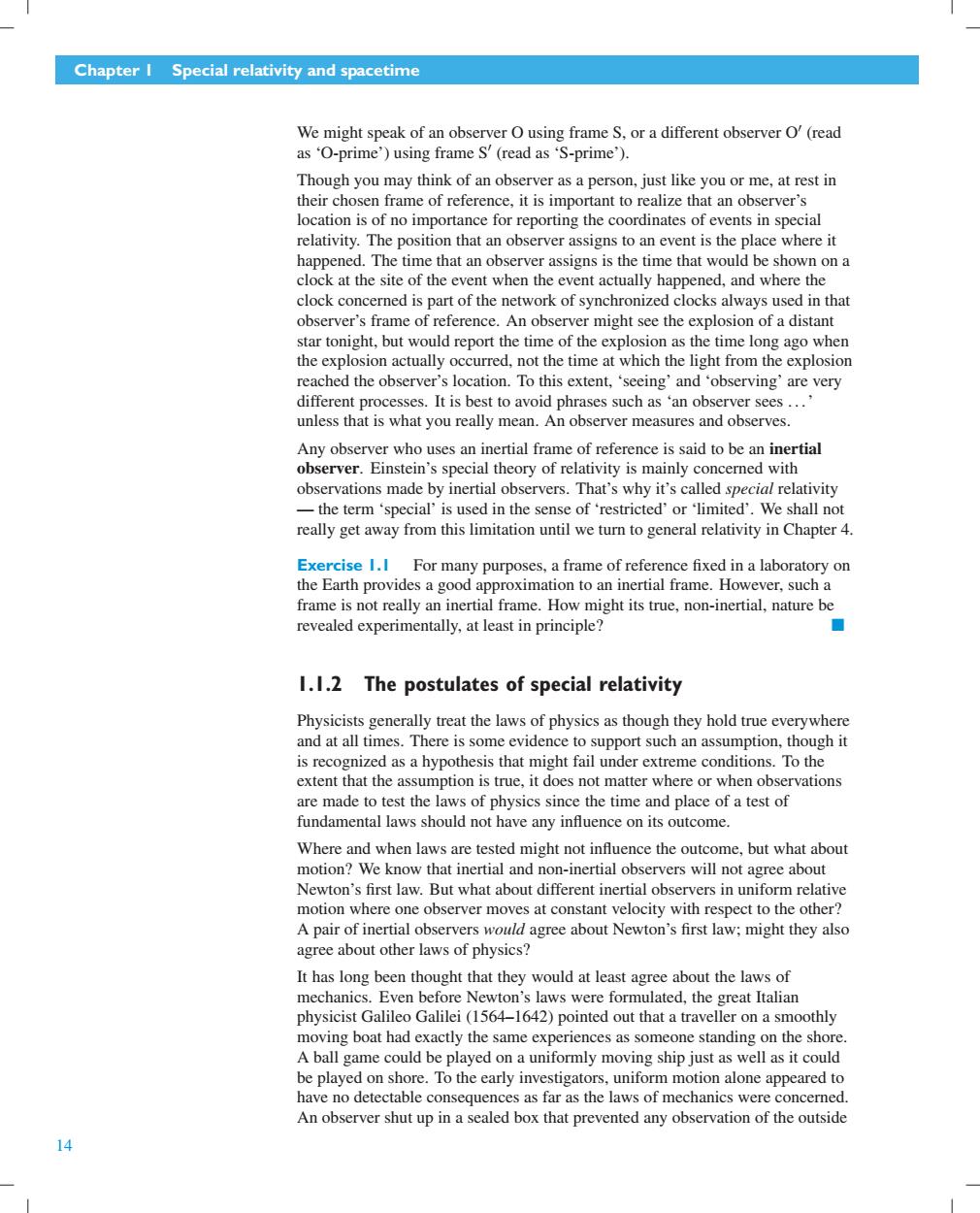
Chapter I Special relativity and spacetime We might speak of an observer O using frame S,or a different observer O'(read as 'O-prime')using frame S'(read as 'S-prime'). Though you may think of an observer as a person,just like you or me,at rest in their chosen frame of reference,it is important to realize that an observer's location is of no importance for reporting the coordinates of events in special relativity.The position that an observer assigns to an event is the place where it happened.The time that an observer assigns is the time that would be shown on a clock at the site of the event when the event actually happened,and where the clock concerned is part of the network of synchronized clocks always used in that observer's frame of reference.An observer might see the explosion of a distant star tonight,but would report the time of the explosion as the time long ago when the explosion actually occurred,not the time at which the light from the explosion reached the observer's location.To this extent,'seeing'and'observing'are very different processes.It is best to avoid phrases such as 'an observer sees... unless that is what you really mean.An observer measures and observes. Any observer who uses an inertial frame of reference is said to be an inertial observer.Einstein's special theory of relativity is mainly concerned with observations made by inertial observers.That's why it's called special relativity -the term 'special'is used in the sense of'restricted'or 'limited'.We shall not really get away from this limitation until we turn to general relativity in Chapter 4. Exercise 1.I For many purposes,a frame of reference fixed in a laboratory on the Earth provides a good approximation to an inertial frame.However,such a frame is not really an inertial frame.How might its true,non-inertial,nature be revealed experimentally,at least in principle? ■ 1.1.2 The postulates of special relativity Physicists generally treat the laws of physics as though they hold true everywhere and at all times.There is some evidence to support such an assumption,though it is recognized as a hypothesis that might fail under extreme conditions.To the extent that the assumption is true,it does not matter where or when observations are made to test the laws of physics since the time and place of a test of fundamental laws should not have any influence on its outcome. Where and when laws are tested might not influence the outcome,but what about motion?We know that inertial and non-inertial observers will not agree about Newton's first law.But what about different inertial observers in uniform relative motion where one observer moves at constant velocity with respect to the other? A pair of inertial observers would agree about Newton's first law;might they also agree about other laws of physics? It has long been thought that they would at least agree about the laws of mechanics.Even before Newton's laws were formulated,the great Italian physicist Galileo Galilei (1564-1642)pointed out that a traveller on a smoothly moving boat had exactly the same experiences as someone standing on the shore. A ball game could be played on a uniformly moving ship just as well as it could be played on shore.To the early investigators,uniform motion alone appeared to have no detectable consequences as far as the laws of mechanics were concerned. An observer shut up in a sealed box that prevented any observation of the outside 14
Chapter 1 Special relativity and spacetime We might speak of an observer O using frame S, or a different observer O % (read as ‘O-prime’) using frame S % (read as ‘S-prime’). Though you may think of an observer as a person, just like you or me, at rest in their chosen frame of reference, it is important to realize that an observer’s location is of no importance for reporting the coordinates of events in special relativity. The position that an observer assigns to an event is the place where it happened. The time that an observer assigns is the time that would be shown on a clock at the site of the event when the event actually happened, and where the clock concerned is part of the network of synchronized clocks always used in that observer’s frame of reference. An observer might see the explosion of a distant star tonight, but would report the time of the explosion as the time long ago when the explosion actually occurred, not the time at which the light from the explosion reached the observer’s location. To this extent, ‘seeing’ and ‘observing’ are very different processes. It is best to avoid phrases such as ‘an observer sees ...’ unless that is what you really mean. An observer measures and observes. Any observer who uses an inertial frame of reference is said to be an inertial observer. Einstein’s special theory of relativity is mainly concerned with observations made by inertial observers. That’s why it’s called special relativity — the term ‘special’ is used in the sense of ‘restricted’ or ‘limited’. We shall not really get away from this limitation until we turn to general relativity in Chapter 4. Exercise 1.1 For many purposes, a frame of reference fixed in a laboratory on the Earth provides a good approximation to an inertial frame. However, such a frame is not really an inertial frame. How might its true, non-inertial, nature be revealed experimentally, at least in principle? ■ 1.1.2 The postulates of special relativity Physicists generally treat the laws of physics as though they hold true everywhere and at all times. There is some evidence to support such an assumption, though it is recognized as a hypothesis that might fail under extreme conditions. To the extent that the assumption is true, it does not matter where or when observations are made to test the laws of physics since the time and place of a test of fundamental laws should not have any influence on its outcome. Where and when laws are tested might not influence the outcome, but what about motion? We know that inertial and non-inertial observers will not agree about Newton’s first law. But what about different inertial observers in uniform relative motion where one observer moves at constant velocity with respect to the other? A pair of inertial observers would agree about Newton’s first law; might they also agree about other laws of physics? It has long been thought that they would at least agree about the laws of mechanics. Even before Newton’s laws were formulated, the great Italian physicist Galileo Galilei (1564–1642) pointed out that a traveller on a smoothly moving boat had exactly the same experiences as someone standing on the shore. A ball game could be played on a uniformly moving ship just as well as it could be played on shore. To the early investigators, uniform motion alone appeared to have no detectable consequences as far as the laws of mechanics were concerned. An observer shut up in a sealed box that prevented any observation of the outside 14
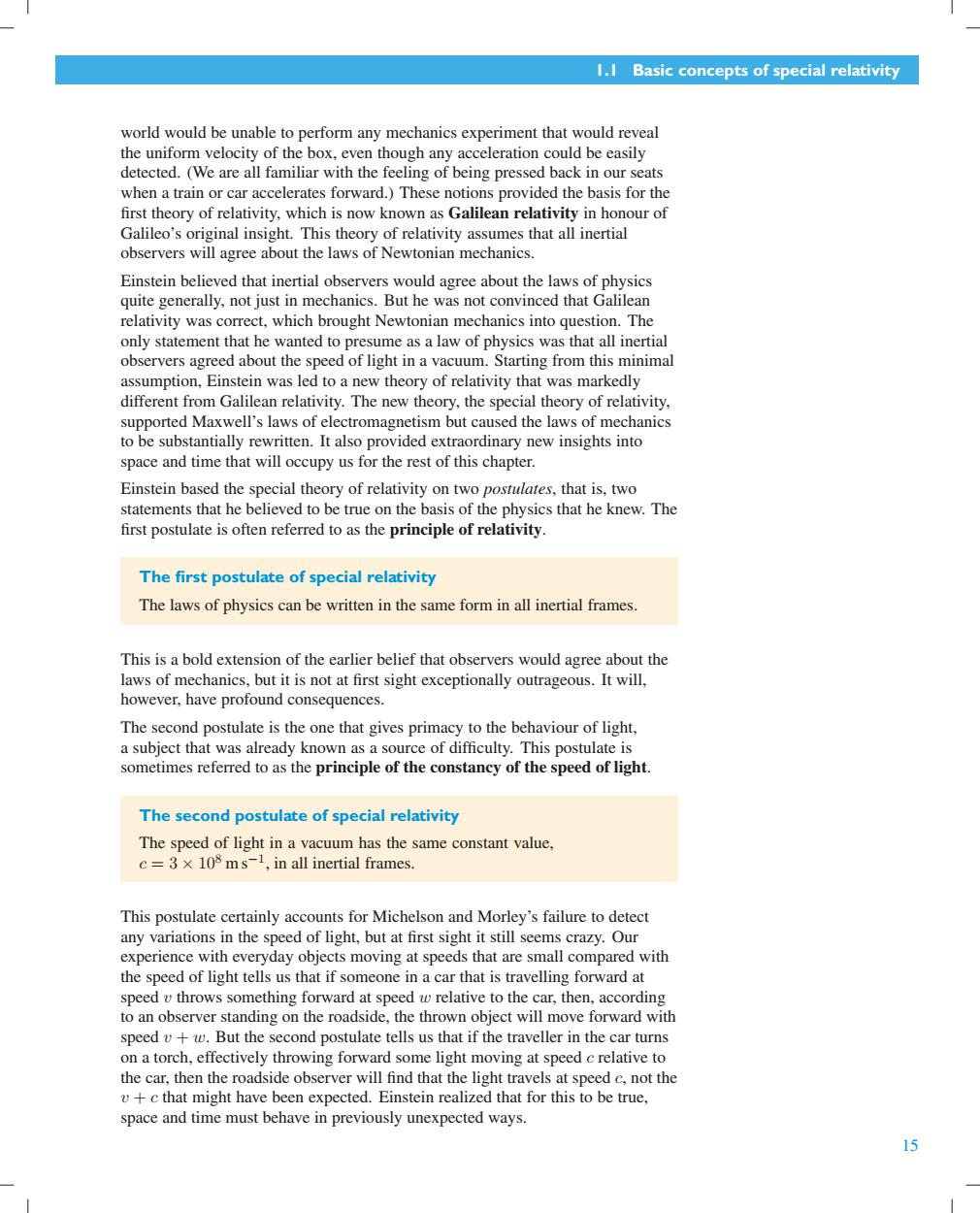
.1 Basic concepts of special relativity world would be unable to perform any mechanics experiment that would reveal the uniform velocity of the box,even though any acceleration could be easily detected.(We are all familiar with the feeling of being pressed back in our seats when a train or car accelerates forward.)These notions provided the basis for the first theory of relativity,which is now known as Galilean relativity in honour of Galileo's original insight.This theory of relativity assumes that all inertial observers will agree about the laws of Newtonian mechanics. Einstein believed that inertial observers would agree about the laws of physics quite generally,not just in mechanics.But he was not convinced that Galilean relativity was correct,which brought Newtonian mechanics into question.The only statement that he wanted to presume as a law of physics was that all inertial observers agreed about the speed of light in a vacuum.Starting from this minimal assumption,Einstein was led to a new theory of relativity that was markedly different from Galilean relativity.The new theory,the special theory of relativity, supported Maxwell's laws of electromagnetism but caused the laws of mechanics to be substantially rewritten.It also provided extraordinary new insights into space and time that will occupy us for the rest of this chapter. Einstein based the special theory of relativity on two postulates,that is,two statements that he believed to be true on the basis of the physics that he knew.The first postulate is often referred to as the principle of relativity. The first postulate of special relativity The laws of physics can be written in the same form in all inertial frames. This is a bold extension of the earlier belief that observers would agree about the laws of mechanics,but it is not at first sight exceptionally outrageous.It will, however,have profound consequences. The second postulate is the one that gives primacy to the behaviour of light, a subject that was already known as a source of difficulty.This postulate is sometimes referred to as the principle of the constancy of the speed of light. The second postulate of special relativity The speed of light in a vacuum has the same constant value, c=3×l0的ms-1,in all inertial frames. This postulate certainly accounts for Michelson and Morley's failure to detect any variations in the speed of light,but at first sight it still seems crazy.Our experience with everyday objects moving at speeds that are small compared with the speed of light tells us that if someone in a car that is travelling forward at speed v throws something forward at speed w relative to the car,then,according to an observer standing on the roadside,the thrown object will move forward with speed v+w.But the second postulate tells us that if the traveller in the car turns on a torch,effectively throwing forward some light moving at speed c relative to the car,then the roadside observer will find that the light travels at speed c,not the v+c that might have been expected.Einstein realized that for this to be true, space and time must behave in previously unexpected ways. 15
1.1 Basic concepts of special relativity world would be unable to perform any mechanics experiment that would reveal the uniform velocity of the box, even though any acceleration could be easily detected. (We are all familiar with the feeling of being pressed back in our seats when a train or car accelerates forward.) These notions provided the basis for the first theory of relativity, which is now known as Galilean relativity in honour of Galileo’s original insight. This theory of relativity assumes that all inertial observers will agree about the laws of Newtonian mechanics. Einstein believed that inertial observers would agree about the laws of physics quite generally, not just in mechanics. But he was not convinced that Galilean relativity was correct, which brought Newtonian mechanics into question. The only statement that he wanted to presume as a law of physics was that all inertial observers agreed about the speed of light in a vacuum. Starting from this minimal assumption, Einstein was led to a new theory of relativity that was markedly different from Galilean relativity. The new theory, the special theory of relativity, supported Maxwell’s laws of electromagnetism but caused the laws of mechanics to be substantially rewritten. It also provided extraordinary new insights into space and time that will occupy us for the rest of this chapter. Einstein based the special theory of relativity on two postulates, that is, two statements that he believed to be true on the basis of the physics that he knew. The first postulate is often referred to as the principle of relativity. The first postulate of special relativity The laws of physics can be written in the same form in all inertial frames. This is a bold extension of the earlier belief that observers would agree about the laws of mechanics, but it is not at first sight exceptionally outrageous. It will, however, have profound consequences. The second postulate is the one that gives primacy to the behaviour of light, a subject that was already known as a source of difficulty. This postulate is sometimes referred to as the principle of the constancy of the speed of light. The second postulate of special relativity The speed of light in a vacuum has the same constant value, c = 3 × 108 m s−1 , in all inertial frames. This postulate certainly accounts for Michelson and Morley’s failure to detect any variations in the speed of light, but at first sight it still seems crazy. Our experience with everyday objects moving at speeds that are small compared with the speed of light tells us that if someone in a car that is travelling forward at speed v throws something forward at speed w relative to the car, then, according to an observer standing on the roadside, the thrown object will move forward with speed v + w. But the second postulate tells us that if the traveller in the car turns on a torch, effectively throwing forward some light moving at speed c relative to the car, then the roadside observer will find that the light travels at speed c, not the v + c that might have been expected. Einstein realized that for this to be true, space and time must behave in previously unexpected ways. 15
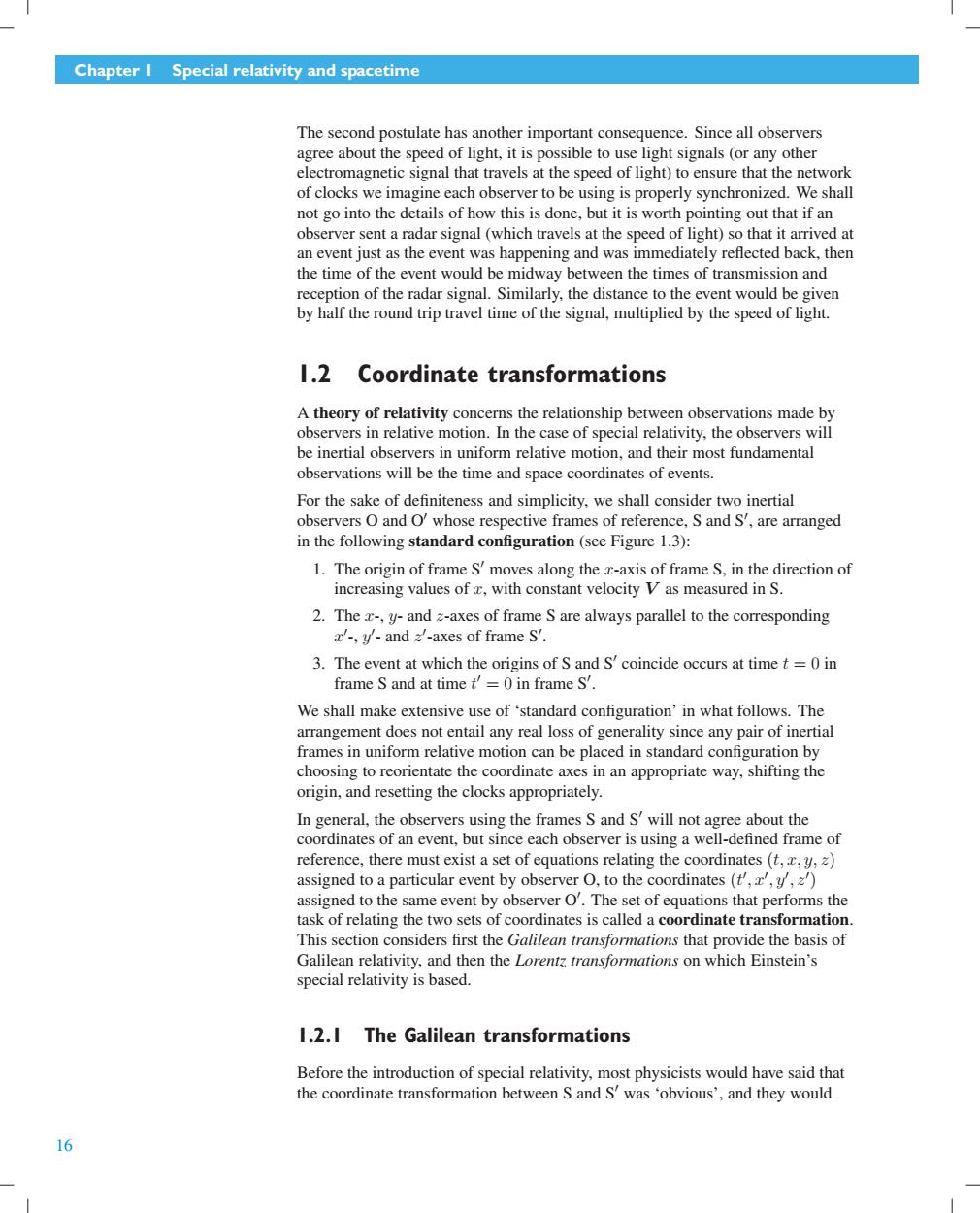
Chapter I Special relativity and spacetime The second postulate has another important consequence.Since all observers agree about the speed of light,it is possible to use light signals(or any other electromagnetic signal that travels at the speed of light)to ensure that the network of clocks we imagine each observer to be using is properly synchronized.We shall not go into the details of how this is done,but it is worth pointing out that if an observer sent a radar signal (which travels at the speed of light)so that it arrived at an event just as the event was happening and was immediately reflected back,then the time of the event would be midway between the times of transmission and reception of the radar signal.Similarly,the distance to the event would be given by half the round trip travel time of the signal,multiplied by the speed of light. 1.2 Coordinate transformations A theory of relativity concerns the relationship between observations made by observers in relative motion.In the case of special relativity,the observers will be inertial observers in uniform relative motion,and their most fundamental observations will be the time and space coordinates of events. For the sake of definiteness and simplicity,we shall consider two inertial observers O and O'whose respective frames of reference,S and S',are arranged in the following standard configuration(see Figure 1.3): 1.The origin of frame S'moves along the c-axis of frame S,in the direction of increasing values of r,with constant velocity V as measured in S. 2.The x-,y-and z-axes of frame S are always parallel to the corresponding x'-,y-and z'-axes of frame S'. 3.The event at which the origins of S and S'coincide occurs at time t =0 in frame S and at time t'=0 in frame S'. We shall make extensive use of 'standard configuration'in what follows.The arrangement does not entail any real loss of generality since any pair of inertial frames in uniform relative motion can be placed in standard configuration by choosing to reorientate the coordinate axes in an appropriate way,shifting the origin,and resetting the clocks appropriately. In general,the observers using the frames S and S'will not agree about the coordinates of an event,but since each observer is using a well-defined frame of reference,there must exist a set of equations relating the coordinates (t,y,2) assigned to a particular event by observer O,to the coordinates (t',,,2) assigned to the same event by observer O'.The set of equations that performs the task of relating the two sets of coordinates is called a coordinate transformation. This section considers first the Galilean transformations that provide the basis of Galilean relativity,and then the Lorentz transformations on which Einstein's special relativity is based. 1.2.I The Galilean transformations Before the introduction of special relativity,most physicists would have said that the coordinate transformation between S and S'was 'obvious',and they would 16
Chapter 1 Special relativity and spacetime The second postulate has another important consequence. Since all observers agree about the speed of light, it is possible to use light signals (or any other electromagnetic signal that travels at the speed of light) to ensure that the network of clocks we imagine each observer to be using is properly synchronized. We shall not go into the details of how this is done, but it is worth pointing out that if an observer sentaradar signal (which travels at the speed of light) so that it arrived at an event just as the event was happening and was immediately reflected back, then the time of the event would be midway between the times of transmission and reception of the radar signal. Similarly, the distance to the event would be given by half the round trip travel time of the signal, multiplied by the speed of light. 1.2 Coordinate transformations A theory of relativity concerns the relationship between observations made by observers in relative motion. In the case of special relativity, the observers will be inertial observers in uniform relative motion, and their most fundamental observations will be the time and space coordinates of events. For the sake of definiteness and simplicity, we shall consider two inertial observers O and O % whose respective frames of reference, S and S % , are arranged in the following standard configuration (see Figure 1.3): 1. The origin of frame S % moves along the x-axis of frame S, in the direction of increasing values of x, with constant velocity V as measured in S. 2. The x-, y- and z-axes of frame S are always parallel to the corresponding x % -, y % - and z % -axes of frame S% . 3. The event at which the origins of S and S % coincide occurs at time t = 0 in frame S and at time t % = 0 in frame S % . We shall make extensive use of ‘standard configuration’ in what follows. The arrangement does not entail any real loss of generality since any pair of inertial frames in uniform relative motion can be placed in standard configuration by choosing to reorientate the coordinate axes in an appropriate way, shifting the origin, and resetting the clocks appropriately. In general, the observers using the frames S and S% will not agree about the coordinates of an event, but since each observer is using a well-defined frame of reference, there must exist a set of equations relating the coordinates (t, x, y, z) assigned to a particular event by observer O, to the coordinates (t % , x% , y% , z% ) assigned to the same event by observer O% . The set of equations that performs the task of relating the two sets of coordinates is called a coordinate transformation. This section considers first the Galilean transformations that provide the basis of Galilean relativity, and then the Lorentz transformations on which Einstein’s special relativity is based. 1.2.1 The Galilean transformations Before the introduction of special relativity, most physicists would have said that the coordinate transformation between S and S % was ‘obvious’, and they would 16
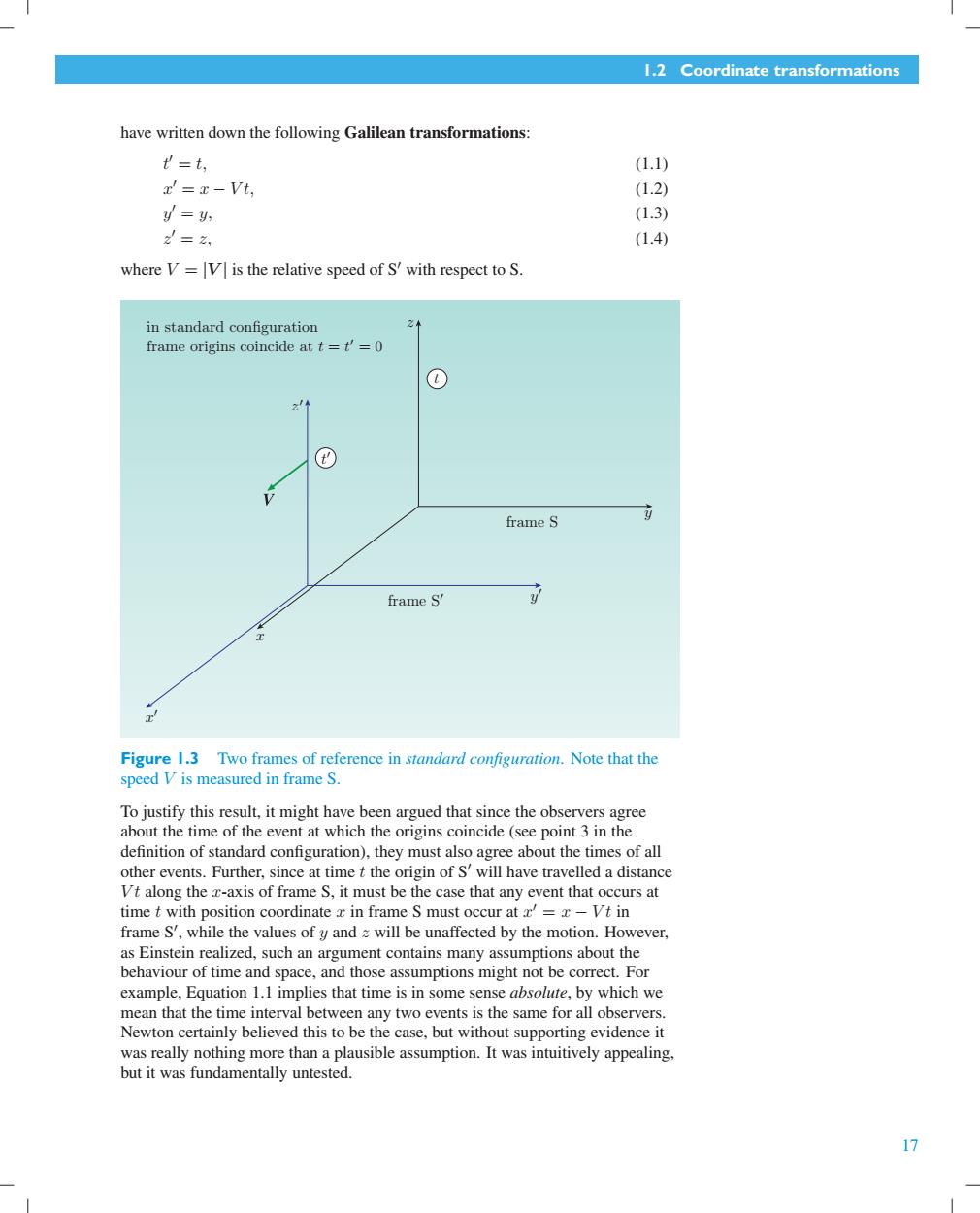
1.2 Coordinate transformations have written down the following Galilean transformations: t=t, (1.1) x'=x-Vt, (1.2) =y, (1.3) 2=2, (1.4) where V=V is the relative speed of S'with respect to S. in standard configuration 2 frame origins coincide at t=t'=0 t frame S frame S' Figure 1.3 Two frames of reference in standard configuration.Note that the speed V is measured in frame S. To justify this result,it might have been argued that since the observers agree about the time of the event at which the origins coincide(see point 3 in the definition of standard configuration),they must also agree about the times of all other events.Further,since at time t the origin of S'will have travelled a distance Vt along the z-axis of frame S,it must be the case that any event that occurs at time t with position coordinate x in frame S must occur at '=x-Vt in frame S',while the values of y and z will be unaffected by the motion.However, as Einstein realized,such an argument contains many assumptions about the behaviour of time and space,and those assumptions might not be correct.For example,Equation 1.1 implies that time is in some sense absolute,by which we mean that the time interval between any two events is the same for all observers. Newton certainly believed this to be the case,but without supporting evidence it was really nothing more than a plausible assumption.It was intuitively appealing, but it was fundamentally untested. 17
1.2 Coordinate transformations have written down the following Galilean transformations: t % = t, (1.1) x % = x − V t, (1.2) y % = y, (1.3) z % = z, (1.4) where V = |V | is the relative speed of S % with respect to S. frame S frame S" in standard configuration frame origins coincide at t = t " = 0 x y z t x " y " z " t " Figure 1.3 Two frames of reference in standard configuration. Note that the speed V is measured in frame S. To justify this result, it might have been argued that since the observers agree about the time of the event at which the origins coincide (see point 3 in the definition of standard configuration), they must also agree about the times of all other events. Further, since at time t the origin of S% will have travelled a distance V t along the x-axis of frame S, it must be the case that any event that occurs at time t with position coordinate x in frame S must occur at x % = x − V t in frame S % , while the values of y and z will be unaffected by the motion. However, as Einstein realized, such an argument contains many assumptions about the behaviour of time and space, and those assumptions might not be correct. For example, Equation 1.1 implies that time is in some sense absolute, by which we mean that the time interval between any two events is the same for all observers. Newton certainly believed this to be the case, but without supporting evidence it was really nothing more than a plausible assumption. It was intuitively appealing, but it was fundamentally untested. 17
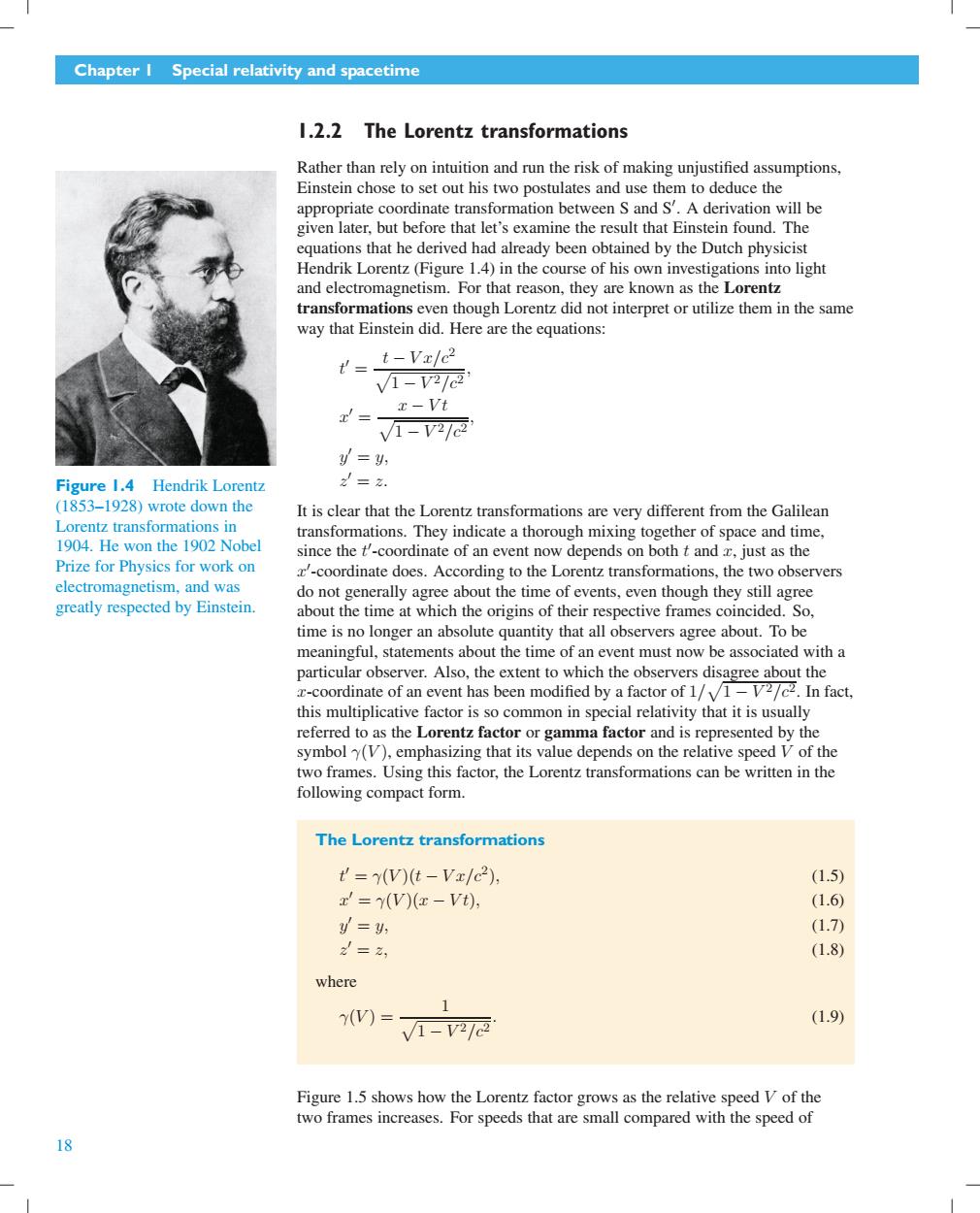
Chapter I Special relativity and spacetime 1.2.2 The Lorentz transformations Rather than rely on intuition and run the risk of making unjustified assumptions, Einstein chose to set out his two postulates and use them to deduce the appropriate coordinate transformation between S and S'.A derivation will be given later,but before that let's examine the result that Einstein found.The equations that he derived had already been obtained by the Dutch physicist Hendrik Lorentz(Figure 1.4)in the course of his own investigations into light and electromagnetism.For that reason,they are known as the Lorentz transformations even though Lorentz did not interpret or utilize them in the same way that Einstein did.Here are the equations: t=_ t-Vzlc2 vV1-V2/c21 t= x-Vt V1-2/21 =y, Figure 1.4 Hendrik Lorentz 之=. (1853-1928)wrote down the It is clear that the Lorentz transformations are very different from the Galilean Lorentz transformations in transformations.They indicate a thorough mixing together of space and time, 1904.He won the 1902 Nobel since the t'-coordinate of an event now depends on both t and x,just as the Prize for Physics for work on x'-coordinate does.According to the Lorentz transformations,the two observers electromagnetism,and was do not generally agree about the time of events,even though they still agree greatly respected by Einstein. about the time at which the origins of their respective frames coincided.So, time is no longer an absolute quantity that all observers agree about.To be meaningful,statements about the time of an event must now be associated with a particular observer.Also,the extent to which the observers disagree about the x-coordinate of an event has been modified by a factor of 1/1-V2/c2.In fact, this multiplicative factor is so common in special relativity that it is usually referred to as the Lorentz factor or gamma factor and is represented by the symbol (V),emphasizing that its value depends on the relative speed V of the two frames.Using this factor,the Lorentz transformations can be written in the following compact form. The Lorentz transformations t=7(V)(t-Vz/c2), (1.5) I'=y(v)(x-Vt), (1.6 y=y, (1.7) 之=, (1.8) where 1 y(V)= (1.9) /1-2/c2 Figure 1.5 shows how the Lorentz factor grows as the relative speed V of the two frames increases.For speeds that are small compared with the speed of 18
Chapter 1 Special relativity and spacetime 1.2.2 The Lorentz transformations Rather than rely on intuition and run the risk of making unjustified assumptions, Einstein chose to set out his two postulates and use them to deduce the appropriate coordinate transformation between S and S % . A derivation will be given later, but before that let’s examine the result that Einstein found. The equations that he derived had already been obtained by the Dutch physicist Hendrik Lorentz (Figure 1.4) in the course of his own investigations into light and electromagnetism. For that reason, they are known as the Lorentz transformations even though Lorentz did not interpret or utilize them in the same way that Einstein did. Here are the equations: Figure 1.4 Hendrik Lorentz (1853–1928) wrote down the Lorentz transformations in 1904. He won the 1902 Nobel Prize for Physics for work on electromagnetism, and was greatly respected by Einstein. t % = t − V x/c2 - 1 − V 2/c2 , x % = x − V t - 1 − V 2/c2 , y % = y, z % = z. It is clear that the Lorentz transformations are very different from the Galilean transformations. They indicate a thorough mixing together of space and time, since the t % -coordinate of an event now depends on both t and x, just as the x % -coordinate does. According to the Lorentz transformations, the two observers do not generally agree about the time of events, even though they still agree about the time at which the origins of their respective frames coincided. So, time is no longer an absolute quantity that all observers agree about. To be meaningful, statements about the time of an event must now be associated with a particular observer. Also, the extent to which the observers disagree about the x-coordinate of an event has been modified by a factor of 1/ - 1 − V 2/c2 . In fact, this multiplicative factor is so common in special relativity that it is usually referred to as the Lorentz factor or gamma factor and is represented by the symbol γ(V ), emphasizing that its value depends on the relative speed V of the two frames. Using this factor, the Lorentz transformations can be written in the following compact form. The Lorentz transformations t % = γ(V )(t − V x/c2 ), (1.5) x % = γ(V )(x − V t), (1.6) y % = y, (1.7) z % = z, (1.8) where γ(V ) = 1 - 1 − V 2/c2 . (1.9) Figure 1.5 shows how the Lorentz factor grows as the relative speed V of the two frames increases. For speeds that are small compared with the speed of 18